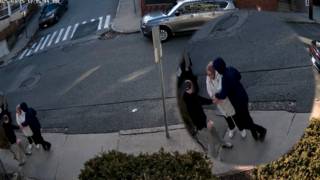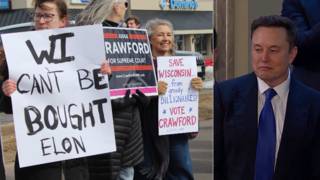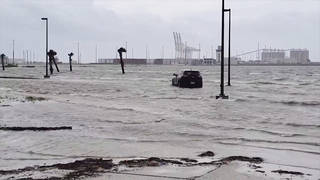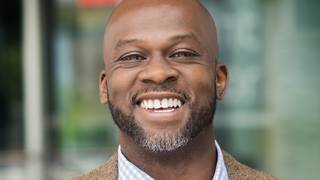
Topics
Guests
- A.C. Thompsonstaff reporter at ProPublica. He is working on an ongoing series for PBS Frontline and the Times Picayune on the post-Katrina shootings in New Orleans.
We get an update on the investigations into a spate of police shootings in New Orleans that took place in the immediate aftermath of Hurricane Katrina. In recent weeks, two former members of the New Orleans police have admitted to participating in a cover-up of the Danziger Bridge shootings of September 4, 2005, when police SWAT units opened fire on a group of unarmed civilians, killing two and wounding four. Meanwhile, federal investigators have widened their probe into the New Orleans Police Department and are now looking into the circumstances surrounding four other incidents that include three deaths and one non-fatal shooting. [includes rush transcript]
Transcript
ANJALI KAMAT: We turn now to an update on the investigations into a spate of police shootings in New Orleans that took place in the immediate aftermath of Hurricane Katrina. In recent weeks, two former members of the New Orleans police have admitted to participating in a cover-up of the Danziger Bridge shootings of September 4th, 2005, when police SWAT units opened fire on a group of unarmed civilians, killing two and wounding four. Meanwhile, federal investigators have widened their probe into the New Orleans Police Department and are now looking into the circumstances surrounding four other incidents that include three deaths and one non-fatal shooting.
AMY GOODMAN: One of these incidents involves the death of a thirty-one-year-old African American man, Henry Glover, whose charred remains were found in the back of a burned car left on the banks of the Mississippi River. Federal investigators reportedly believe a police officer shot Glover, and other officers later burned a car with his body inside. Now, according to a report by the Times Picayune and ProPublica, what really happened in this case might have also been covered up by the New Orleans Police Department.
For more on this story, we’re joined here in New York by the ProPublica reporter A.C. Thompson, who broke the story and has been writing an ongoing series for PBS Frontline and the Times Picayune on the post-Katrina shootings in New Orleans.
A.C., welcome to Democracy Now! Tell us exactly what you have found out.
A.C. THOMPSON: First I should say that this project that we’ve been doing, the reporting there, has been with the Times Picayune and my colleagues there and PBS Frontline, so we’re all working together on this.
But what we’re learning about the Henry Glover shooting, and his death, when he was burned up in the car on the banks of the Mississippi River, is that the police report that was generated documenting the officer-involved shooting involving Mr. Glover looks to have been altered, fabricated, changed from its original form from what was originally submitted to the police department. And so, the document that we have, the document that we believe the federal government has, does not seem to be the true, genuine, authentic, original police report. And so, that makes it look a lot more like what happened with the Danziger Bridge incident, where you had a police shooting — six people were shot, two people were killed — and then we now know, because of the federal indictments and the guilty pleas, that the investigative reports into those shootings were fabricated, forged, faked.
AMY GOODMAN: Who was Henry Glover?
A.C. THOMPSON: Henry Glover was a thirty-one-year-old man. He lived on the west bank of the Mississippi in New Orleans. He was a father of four. And on September 2nd, 2005, somebody, we believe probably a New Orleans police officer, shot him a single time in the chest. He was rescued by a Good Samaritan who drove him, ironically, to a place where police were camped out, thinking that the police could help him, give him medical aid, and save his life. But according to three different witnesses that I’ve interviewed, the police didn’t offer any assistance. What they instead did was they let Henry Glover bleed to death in the backseat of the car, and they physically assaulted the men that he was with, including the Good Samaritan. What we know happened after that is the car the Good Samaritan was driving and Henry Glover’s body were found behind a police station on the banks of the Mississippi River, and just — they were completely incinerated. There was almost nothing left. So, we have photos, video of Mr. Glover’s remains. And we’re talking about bone fragments, charred flesh, ashes — very little left.
AMY GOODMAN: Who was the Good Samaritan?
A.C. THOMPSON: The Good Samaritan was William Tanner, who is really the person who got this story out there and spoke to me first and spoke —- and has been speaking and saying this was insane, this was terrible, and really trying to get the story out there.
ANJALI KAMAT: And A.C., put this into a broader context. The Times Picayune had an editorial earlier this week describing what they called a grotesque and nauseating pattern of police cover-ups.
A.C. THOMPSON: Here’s the pattern, is that in the week after Hurricane Katrina, ten to eleven, possibly more, people were shot by the New Orleans Police Department. Now, the narrative that we had at the time was the citizens are running amok. More and more, it looks like perhaps the police were running amok.
And what we know about these shootings is, in two cases now, we have cases of fabricated documents or altered documents. In multiple cases, we have incidents where citizens were shot in the back. And that immediately raises suspicions that these were not good police shootings, that these were unnecessary uses of force. When somebody is shot in the back, you wonder if they’re really posing a threat to the officers.
As well, in the Glover case, in the Danziger Bridge case, and several other cases, we have these allegations that citizens were possessing a weapon, or they were possessing something that looked like a weapon, and so police had to shoot at them. But in multiple cases, we’ve now found that those people didn’t have a weapon. And again, it makes us question whether these were good shootings or not.
AMY GOODMAN: Explain the Danziger Bridge incident.
A.C. THOMPSON: The Danziger Bridge incident happened on September 4th, 2005. And so, that morning, as we understand it -—
AMY GOODMAN: Right after Hurricane Katrina.
A.C. THOMPSON: Yeah, less than a week after the storm had hit and the levees broke. That morning, as we understand it, police got a call that two officers were, quote, “down” under the Danziger Bridge. And from what we understand, they read that to mean they had been shot, they were wounded. And so, a truckload of officers stormed to the bridge in a rented — a commandeered rental truck and jumped out of the truck. And they say that they immediately came under fire from citizens who were on the bridge. But what we’re learning from the plea deals that are coming out in federal court is that other officers are saying, no, the citizens were not shooting, there was no gunfire, the people who started shooting were the police, immediately. That’s what we’re learning from the federal court hearings and the plea deals. So what happens is, the officers jump out, begin shooting, and six citizens get hit. And these are not minor wounds. One woman lost her arm. One man said that he was shot twice in the stomach at point-blank range. And two people were killed. So this is a very, very serious incident.
AMY GOODMAN: Who were those two people?
A.C. THOMPSON: That would be James Brissette and Ronald Madison. And in Ronald Madison’s case, he was a forty-year-old man. He was mentally retarded. And we believe that he was chased off the bridge and into a hotel parking lot and then shot repeatedly in the back. If you look at his autopsy report, he was shot over and over again from behind.
ANJALI KAMAT: A.C., talk about the other cases.
A.C. THOMPSON: The other cases that we’ve been looking at in our series and in our reporting involve Matthew McDonald. Now, Matthew McDonald was a drifter from Connecticut. He was shot in the Marigny district of New Orleans. And again, he was shot in the back. He was shot with an assault rifle. And the claim there is that he had a gun in a plastic bag and was menacing police officers. In light of everything else we’ve seen, we have to have a little skepticism about that claim. In that case, the gun that he supposedly had was checked into evidence about a month after the event happened, so it’s another thing that makes you wonder what was going on.
Danny Brumfield was shot in the back in front of the Convention Center, either on September 2nd or September 3rd — it’s in dispute. And in that case, he supposedly had a pair of scissors that he was menacing an officer with. And again, his family says, “We don’t believe that. We were there. We saw this. And we don’t think that’s the case.” The police say, you know, “He was a threat. He was going to kill us.”
The last case we’ve been looking at is Keenan McCann. And Keenan McCann, again, the police said that he had a gun, he was threatening officers, and so they shot him repeatedly with assault rifles. He survived. And when they got down there and investigated, there was no gun. He didn’t have a gun, not on him at that time. So these are the questions that come up. Were these good shootings? Is the story that we’re getting in these cases accurate?
ANJALI KAMAT: I want to go to a story from Baton Rouge. The Baton Rouge Advocate published a damning exposé last week talking about allegations of misconduct by police officers in Baton Rouge after Hurricane Katrina. And some of the quotes from here are quite astounding. Visiting officers said Baton Rouge police referred to African Americans as, quote, “heathens and animals that needed to be beaten down.” Where did these allegations come from? Talk about this exposé.
A.C. THOMPSON: That’s what’s amazing about this story, is in this case, these were state troopers from New Mexico and Michigan who came in to help the Baton Rouge police officers in the wake of Hurricane Katrina. They were coming there to render assistance and back them up. And they were pulled out after only two days, because the out-of-state cops were complaining about what they saw. And they said, “Look, there’s this pattern of abusive and racist policing going on here, and we want out.” So they’re the ones making these allegations. These are not private citizens. These are other officers saying, this was wrong, we saw this, and it was just absolutely out of control.
AMY GOODMAN: The judge in the case of the shootings, the killings of James Brissette, nineteen years old, who was with a mentally handicapped man, mentally retarded man, who you were just describing, Ronald Madison, both of them killed — they were searching for food, they were on the bridge — the judge in the case, where the officers pleaded guilty, Judge Lance Africk, said, “I have neither imagined or heard of more despicable conduct by law enforcement officers.” Talk about the secret meeting that these law enforcement officers had to conspire over how to conduct the cover-up of the Danziger Bridge shootings.
A.C. THOMPSON: Well, you know, what’s coming out from these plea deals, from these guilty pleas, is that it seems like there was an ongoing conspiracy to cover up these — to cover up these incidents. So you hear these things in the plea deals, like —- in one case, an investigator has a paper bag, and other officers come to his house, and they say, “What’s in the bag?” And he says, “A ham sandwich.” He opens up the bag, and it’s a handgun. And that handgun, according to the guilty plea, in one of these cases, is the gun that gets dumped on the bridge to implicate the citizens as having attacked the NOPD, which we now know didn’t happen. I mean, these are really stunning sort of things that you hear about. In another case, another incident -—
AMY GOODMAN: We have ten seconds.
A.C. THOMPSON: Yeah, it’s just cinematic. It’s really mind-blowing.
AMY GOODMAN: Well, we will continue to talk to you as you continue this investigation. It’s absolutely explosive and remarkable. And thank you for all the work that you’ve done in uncovering it. A.C. Thompson, staff reporter for ProPublica, ongoing series with PBS Frontline
and working with the Times Picayune, as well, on the post-Katrina shootings by police in New Orleans.












Media Options